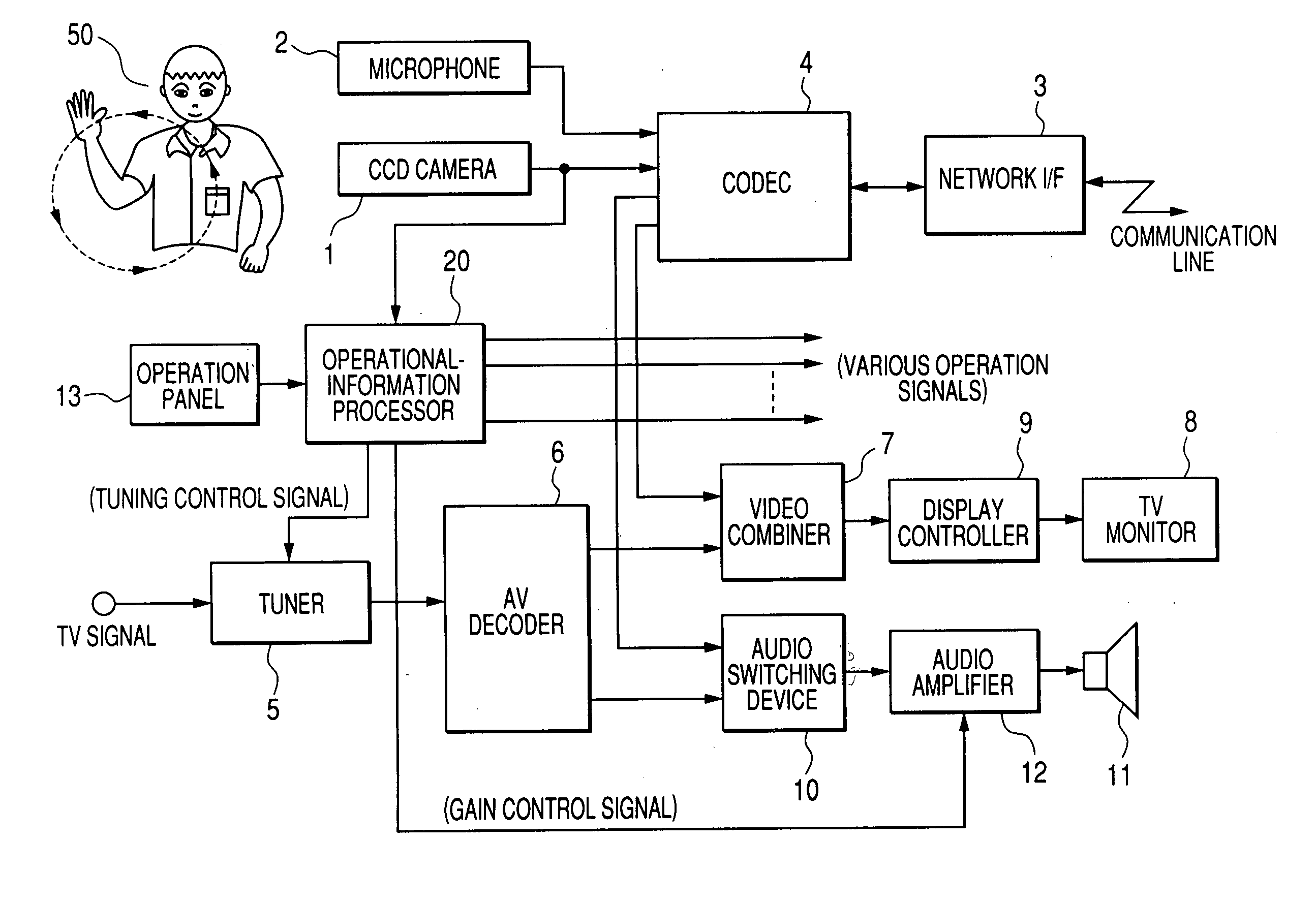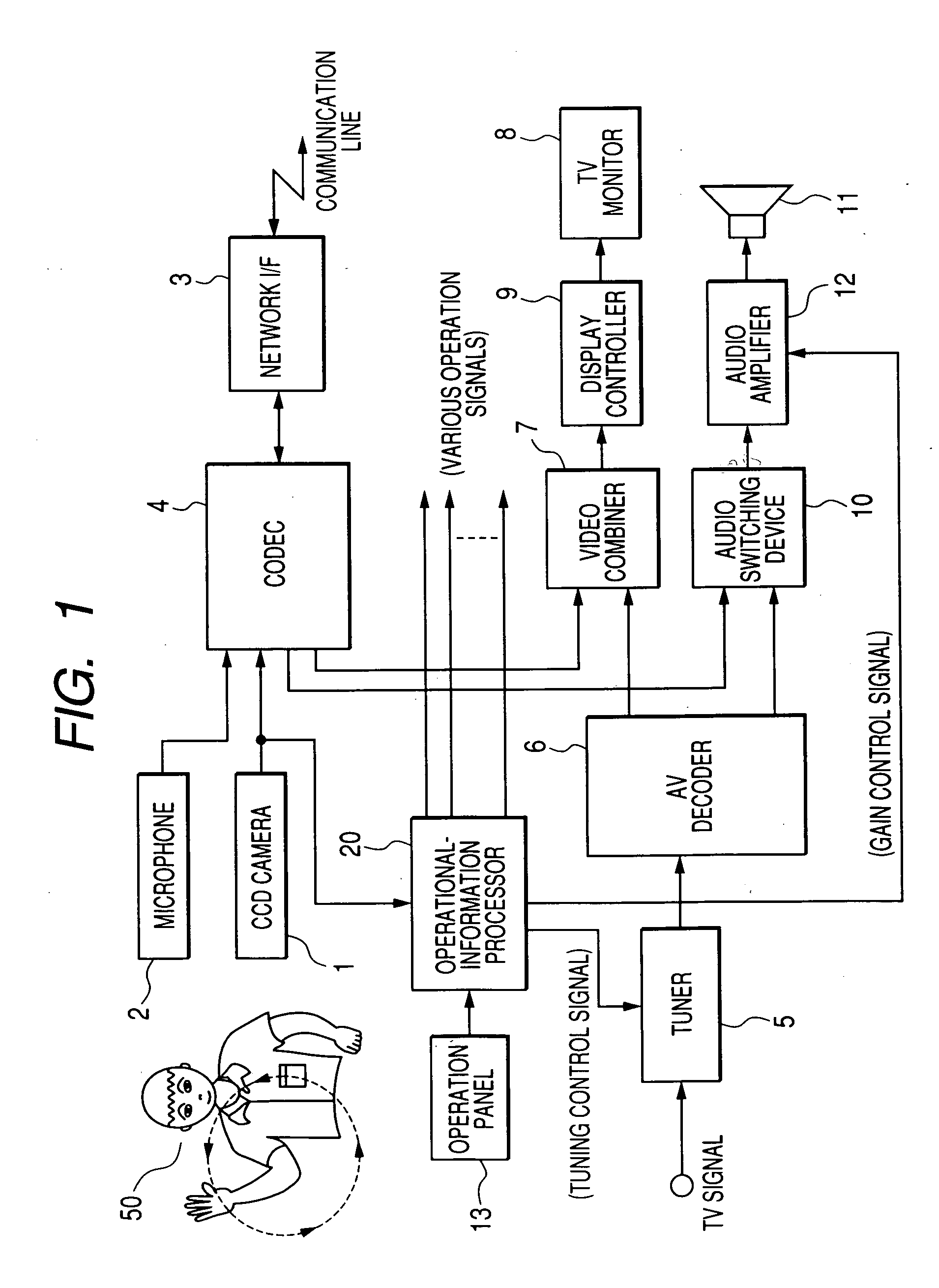Method and apparatus for entering desired operational information to devices with the use of human motions
a technology of operating information and input method, applied in the direction of electric digital data processing, instruments, computing, etc., can solve the problems of not explicitly describing an analysis algorithm to detect, the apparatus and system for occlusion of input has still faced various difficulties, and the practical technique for detecting circular actions of the hand is not given
- Summary
- Abstract
- Description
- Claims
- Application Information
AI Technical Summary
Benefits of technology
Problems solved by technology
Method used
Image
Examples
first embodiment
[0042] Referring to FIGS. 1-9, a first embodiment of the operational-information entering apparatus will now be described.
[0043]FIG. 1 shows in block form the configuration of a TV (television) receiver with a camera having a video phone function. The TV receiver is provided with a CCD camera 1 that is able to image an operator (a person who uses the phone) and a microphone 2 collecting sound. This TV receiver is also provided with a network I / F 3 that transmits and receive packets of video and audio data via a communication line in a TV phone mode, in addition to various other components, such as a codec 4, a tuner 5, an AV decoder 6, a video combiner 7, a TV monitor 8, a display controller 9, a video switching device 10, speakers 11, an audio amplifier 12, an operation panel 13, and an operational-information processor 20.
[0044] Of these components, the codec 4 is configured to, in the TV phone mode, not only code video and sound signals acquired from the CCD camera 1 and microp...
second embodiment
[0083] Referring to FIGS. 10-14, a second embodiment of the operational-information entering apparatus will now be described. In the present embodiment and successive embodiments, the identical our similar components to those in the first embodiment will be given the same reference numerals for the sake of simplified explanations.
[0084] The second embodiment is characteristic of having the function of entitling operator's hand circular motions to command dual objective items being operated.
[0085] To put it briefly, although image data are subjected to analysis in the same way as that in the first embodiment in which it is determined whether or not operator's hand motions are along a circular orbit and the rotational direction is checked, the second embodiment additionally involves the determination of two successive circular rotations of an operator's hand. Of the two successive rotations that have been detected, the rotational directions of the former rotation are used as informa...
third embodiment
[0102] Referring to FIGS. 15-22, a third embodiment of the operational-information entering apparatus according to the present embodiment will now be described.
[0103] The operational-information entering apparatus of third embodiment relates to a scheme that allows plural operators (for example, two operators) moves their hands for entering operational information in front of the camera.
[0104] The foregoing first and second embodiments have been explained about the configuration where only one operator gives hand motions to the camera for the remote control. However, this is not always true, but plural persons can perform such remote control. In that case, it is necessary for the entering apparatus to receive motional information, person by person, without receiving simultaneously the motional information of the plural persons. In other words, it is required to select motions of either one or any one of the operators in preference to the other(s). For example, as shown in FIG. 15,...
PUM
 Login to View More
Login to View More Abstract
Description
Claims
Application Information
 Login to View More
Login to View More - R&D
- Intellectual Property
- Life Sciences
- Materials
- Tech Scout
- Unparalleled Data Quality
- Higher Quality Content
- 60% Fewer Hallucinations
Browse by: Latest US Patents, China's latest patents, Technical Efficacy Thesaurus, Application Domain, Technology Topic, Popular Technical Reports.
© 2025 PatSnap. All rights reserved.Legal|Privacy policy|Modern Slavery Act Transparency Statement|Sitemap|About US| Contact US: help@patsnap.com



